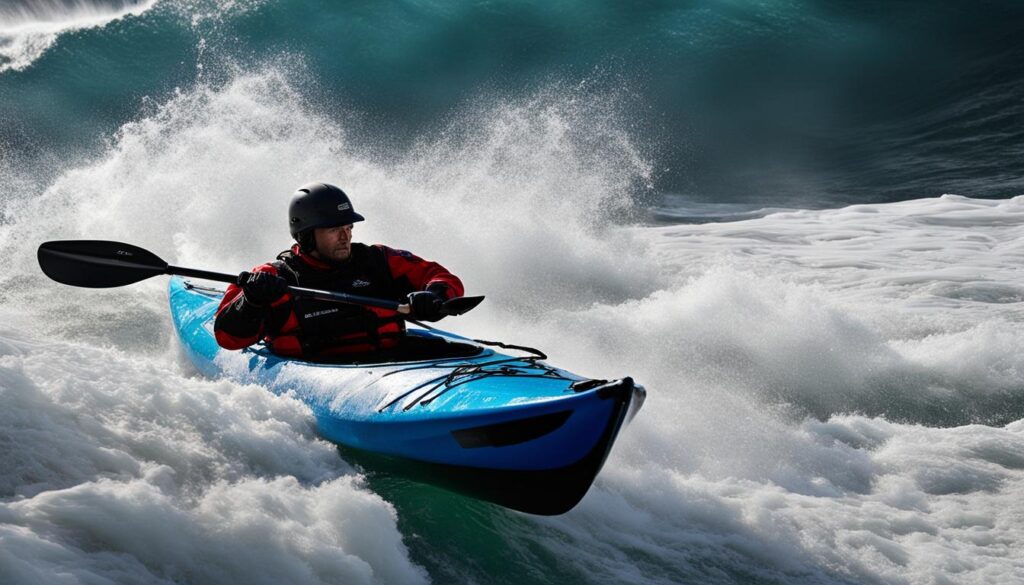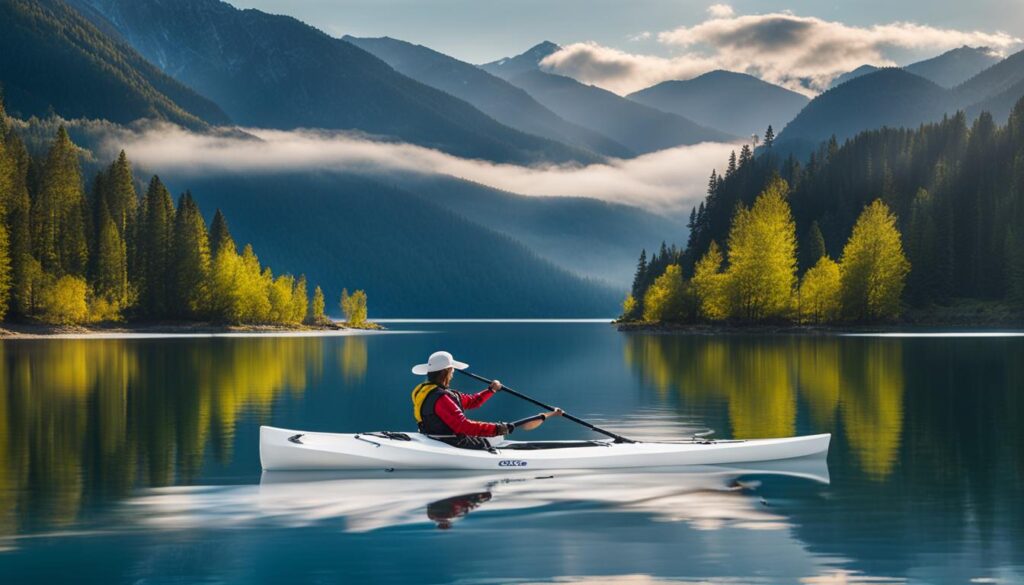The popularity of kayaking as a recreational activity has been on the rise, with nearly 18.6 million Americans going kayaking at least once in 2021. Kayaking offers a chance to connect with nature and provides relaxation and exercise. However, to ensure that kayaking is accessible to everyone, including those with mobility limitations or physical disabilities, it is important to adapt kayak designs for different environments and incorporate inclusive features. Adaptive kayak designs can accommodate various needs, such as spinal cord injuries, paralysis, coordination problems, arthritis, and cognitive disabilities.
Key Takeaways:
- Adapting kayak designs is crucial for making kayaking accessible to individuals with disabilities.
- Inclusive features in kayak designs can cater to various needs, such as spinal cord injuries and cognitive disabilities.
- Adaptive paddling programs offer opportunities for individuals with disabilities to enjoy kayaking in different environments.
- Environmental considerations play a vital role in designing kayaks for specific water types.
- Consultations with certified adaptive paddling instructors can provide guidance on equipment customization and techniques for different weather conditions.
Who Can Kayak?
Kayaking is a recreational activity that is inclusive and can be enjoyed by individuals with a wide range of abilities. Many adaptive paddling programs cater to individuals with different disabilities, including spinal cord injuries, paralysis, balance or coordination problems, arthritis, traumatic brain injuries, cognitive/intellectual disabilities, and more. These programs use adaptive kayak equipment to increase people’s independence and enable them to enjoy kayaking in various environments, such as rivers, oceans, and calm waters. Adaptive kayak designs can be customized to meet the specific needs and abilities of each individual.
Adapting kayak designs for rivers involves incorporating features that enhance stability, maneuverability, and safety. Kayaks designed for river kayaking typically have a more rounded hull shape and shorter length to navigate through fast-moving currents. They may also have increased rocker and chine to improve agility and responsiveness. Additionally, river kayaks often feature reinforced hulls and additional flotation to withstand rugged river conditions.
“Kayaking in the ocean requires specialized adaptations to ensure safety and performance. Ocean kayaks are designed to handle open water conditions and challenging swells. These kayaks are typically longer and narrower than their river counterparts, allowing for increased speed and efficiency. They also have a more pronounced keel to improve tracking and stability in rough conditions. Ocean kayaks may have additional safety features, such as self-bailing cockpits, deck lines, and hatches for storage.”
For calm waters, such as lakes or ponds, kayak designs focus on stability and comfort. These kayaks are often wider, providing a more stable platform for beginners or individuals with balance issues. They may also feature a larger cockpit for easier entry and exit. Additionally, calm water kayaks may have adjustable seating systems and padded backrests or seats for enhanced comfort during extended paddling trips.
| River Kayak | Ocean Kayak | Calm Water Kayak | |
|---|---|---|---|
| Features | Rounded hull, shorter length, increased rocker and chine, reinforced hull, additional flotation | Longer and narrower, pronounced keel, self-bailing cockpit, deck lines, hatches | Wider, larger cockpit, adjustable seating, padded backrests/seats |
| Benefits | Improved agility, responsiveness, and stability in fast-flowing rivers | Enhanced speed, efficiency, tracking, and stability in open water | Increased stability and comfort for calm water paddling |
Adaptive Kayaking Tools & Resources
When it comes to adapting kayak designs for different environments, there are various tools and resources available to ensure an inclusive and enjoyable experience for all kayakers. Organizations such as Ability 360, Adaptive Adventures, and Daring Adventures offer adaptive kayak equipment and support to individuals with disabilities.
One of the key considerations in kayak design is the environmental factors of the intended water type. For kayaking in rough seas, additional stability features like outriggers or stabilizing floats can be incorporated into the kayak design. These features provide enhanced stability and balance, making it easier to navigate through choppier waters.
Another important aspect of adaptive kayak design is customizing the kayak for different water types. Different hull designs and sizes can be utilized to optimize performance and maneuverability based on the specific water conditions. For example, kayaks designed for rivers may have a more streamlined and agile shape compared to those designed for calm lakes.

Gear Recommendations
- Stabilizing floats or outriggers for added stability in rough waters
- Adjustable seating systems to accommodate different body types and comfort levels
- Adaptive paddles with ergonomic grips for improved control and reduced strain
- Protective gear such as splash guards or spray skirts for protection from water and wind
By considering environmental factors and customizing kayak designs, individuals with disabilities can experience the joy of kayaking in various water types. These adaptive features and resources not only enhance safety and comfort but also promote inclusivity in outdoor recreation.
Adaptive Consultations and Equipment
For individuals with significant disabilities who are interested in adaptive kayaking, there are certified adaptive paddling instructors available for consultations. These consultations can provide guidance on choosing the right kayak, equipment customization, and techniques for different weather conditions.
When customizing kayaks for lake use, it is important to consider various factors such as hull shape, size, and stability. Lake kayaking often requires kayaks with good tracking and maneuverability to navigate calm waters effectively. In consultations, instructors can help individuals select kayaks that offer the optimal combination of stability and performance for lake kayaking.
Kayak modifications for various weather conditions are crucial to ensure safety and comfort. Instructors can provide recommendations on adding protective gear, such as spray skirts or paddle jackets, to shield against wind and water splashes. They can also suggest adjustments to seating systems to enhance support and alleviate discomfort during long hours of kayaking in different weather conditions.
| Considerations for Customizing Kayaks for Lake Use | Kayak Modifications for Various Weather Conditions |
|---|---|
|
|
Adaptive consultations provide a valuable opportunity for individuals with disabilities to receive personalized advice on customizing kayaks for lake use and modifying them for different weather conditions. With the guidance of adaptive paddling instructors, kayakers can enjoy the beauty of lakes and adapt their kayaks to be suitable for their specific needs and preferences.

Expert Advice: Customizing for Lake Use
“When customizing a kayak for lake use, it’s important to prioritize stability and maneuverability. Look for a kayak with a wider hull for better stability on calm waters. Additionally, consider the length of the kayak, as shorter kayaks tend to be more maneuverable, while longer kayaks offer better tracking. Don’t forget to choose a comfortable seating system that provides adequate support for longer journeys on the lake. Consult with adaptive paddling instructors to find the perfect kayak that suits your specific needs and preferences.”
Expert Advice: Kayak Modifications for Weather Conditions
“Weather conditions can significantly impact your kayaking experience, so it’s crucial to make appropriate modifications. Adding protective gear, such as spray skirts or paddle jackets, can shield you from wind and water splashes. Consider adjusting your seating system to optimize support and comfort, especially during long hours on the water. Depending on the weather, you may also want to invest in weather-specific equipment, such as sun hats or rain covers. Consulting with adaptive paddling instructors will ensure you make the necessary modifications to enhance safety and enjoyment while kayaking in different weather conditions.”
Conclusion
Adapting kayak designs for different environments is crucial in making kayaking accessible and enjoyable for everyone. By taking into account factors like environmental conditions, individual abilities, and equipment customization, kayaks can be tailored for various water types, including saltwater and freshwater. Incorporating adaptive features, such as stabilizing floats, adaptive paddles, and seating systems, enhances safety, stability, and comfort for individuals with disabilities. It is crucial to continue striving for inclusivity in outdoor recreation and to promote the benefits of adaptive kayaking for people of all abilities.
When designing kayaks for saltwater use, it is essential to consider the corrosive effects of saltwater and choose materials that can withstand its harsh conditions. Additionally, saltwater kayaks may require enhanced stability and maneuverability features to handle the unique challenges of ocean environments. On the other hand, adapting a kayak for freshwater use may involve considerations such as weight management, hull design, and flotation devices suitable for calmer waters. Customizing kayaks for different water types ensures optimal performance and enjoyment.
As the popularity of kayaking continues to grow, it is imperative to prioritize inclusivity and provide adaptive solutions for individuals with disabilities. By making kayak designs accessible and versatile, more people can experience the thrill and tranquility of kayaking in a wide range of environments. Whether it’s exploring the open ocean, paddling on serene lakes, or navigating rivers and streams, adaptive kayak designs play a crucial role in ensuring that the joy of kayaking knows no bounds.
FAQ
What disabilities can be accommodated with adaptive kayak designs?
Adaptive kayak designs can accommodate various needs, such as spinal cord injuries, paralysis, coordination problems, arthritis, and cognitive disabilities.
Who can enjoy kayaking with adaptive paddling programs?
Many adaptive paddling programs cater to individuals with disabilities, including spinal cord injuries, paralysis, balance or coordination problems, arthritis, traumatic brain injuries, cognitive/intellectual disabilities, and more.
Which organizations support individuals with disabilities in kayaking?
Some organizations that use adaptive kayak equipment to support individuals with disabilities include Ability 360, Adaptive Adventures, Daring Adventures, and more.
How can kayaks be adapted for different environments?
Kayaks can be adapted for different environments by considering factors such as environmental conditions, water types, and equipment customization.
Are there consultations available for individuals with significant disabilities interested in adaptive kayaking?
Yes, there are certified adaptive paddling instructors available for consultations. These consultations can provide guidance on choosing the right kayak, equipment customization, and techniques for different weather conditions.
What modifications can be made to adapt kayaks for specific environments?
Kayaks can be modified for specific environments by considering factors such as hull shape, size, stability, and adding protective gear or adjusting seating for comfort and support.
Why is it important to adapt kayak designs for different environments?
Adapting kayak designs for different environments is essential to ensure that kayaking is accessible and enjoyable for everyone. It allows for optimal performance, safety, stability, and comfort for individuals with disabilities.
Can kayaks be adapted for saltwater and freshwater use?
Yes, kayaks can be adapted for various water types, including saltwater and freshwater, by considering environmental conditions and making necessary modifications.





